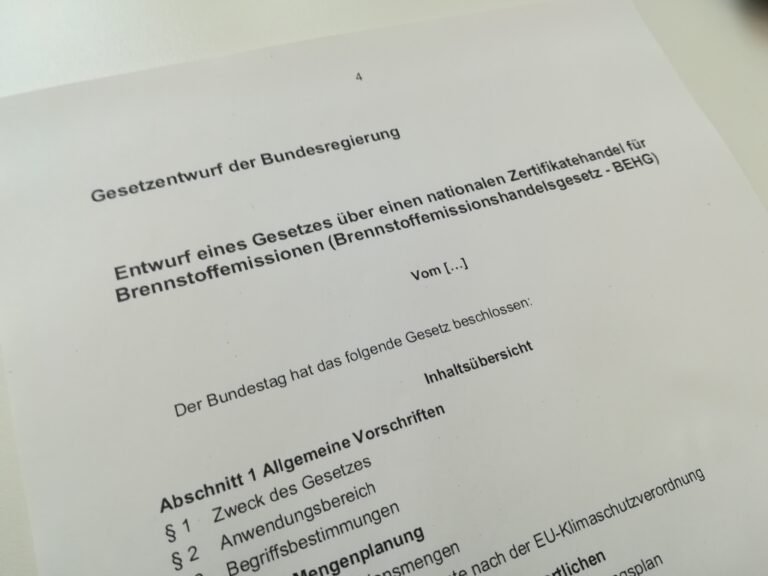The national emissions trading system for transport and heating fuels will exist in parallel with the EU-wide emissions trading system and cover the bulk of greenhouse gas emissions not included in the emissions trading system. There will be some overlap as fuel is already covered in ETS, but will also be priced in the new system. The law already provides for companies to be compensated, and the additional regulation aims to avoid companies having to pay twice in the first place.
The new system will be a “cap-and-trade” system in which the federal government sets an annual aggregate emissions limit for transport and heating fuels in line with its total annual non-ETS targets set in the EU. The EU Effort Sharing Program stipulates annual greenhouse gas emissions budgets for all non-ETS sectors combined. However, it also includes emissions that do not come from burning transportation and heating fuels, such as methane emissions in agriculture. It will not be covered by the planned German system.
Emissions allowances are transferable and tradeable. It will generally be auctioned off. However, during the initial phase there will be a fixed price at which it will simply be sold to companies (2021-2025).
The federal government says implementing the system will cost companies around 31 million euros a year due to increased bureaucracy and the necessary infrastructure.
The responsible government body is the Federal Environment Agency (UBA).
From 2027, the national CO2 price will be replaced by a second EU standard (which operates separately from the current EU ETS), which includes emissions in the buildings and transport sectors (more below).
What and who will be priced?
Transport and heating fuels, such as gasoline, diesel, heating oil, natural gas and coal, covers heating emissions in the buildings sector, energy installations and industry that are not covered by the EU ETS, covers transport emissions excluding air transport and does not cover non-fuels Emission participants (eg methane in agriculture) are not They are the emitters themselves, but the companies that put the fuel into circulation or the fuel suppliers (initial approach) The government says this means around 4,000 companies will take part. To avoid the double burden of the national system and the ETS, fuel deliveries to facilities are exempt. ETS” from the national price; Where this results in disproportionate administrative needs, there will be compensation
the price
Fixed price in 2021: 25 euros per allowance (tonne CO2 equivalent) (meaning an increase of about 7 cents in the price of a liter of gasoline, and 8 qt/l of diesel); 2022: 30 euros; 2023: 30 euros, 2024: 45 euros (about 8.4 cents increase in the price of a liter of gasoline, and 9.5 kt/l of diesel); 2025: €55 in 2026 at auctions, with a price corridor between €55-65 from 2027: market price, with option for price corridors (to be determined in 2025)
Following the German government’s budget crisis in December 2023 and in an attempt to consolidate its reformed budget plans, the ruling coalition decided to increase the CO2 price from the planned 40 euros to 45 euros from January 2024. For 2025, it decided The Social Democrats, the Greens and the pro-business Liberal Democrats agreed to increase the price to €55 per allowance, from the planned €45.
Flexibility
During the fixed price/price corridor phase: If the emissions budget is insufficient and targets are missed in non-ETS sectors, Germany will use the flexibility of the EU effort-sharing scheme – this may include purchasing emissions allowances from other member states
Revenues
The government expects the new system to generate revenues of €40 billion in 2021-2024 (the budget planning period at that time). In 2023, revenues from the national CO2 price jumped by 67% to €10.7 billion, compared to 2022. The revenues will go to the Climate and Transition Fund (KTF), which is used, among other things, to renovate energy-efficient buildings and replace boilers. Supporting renewable electricity feed-in, launching electric mobility infrastructure and the emerging hydrogen industry, as well as relief measures for citizens and industry, and programs to support climate action.
Reducing emissions
Based on projections, the government expects the price to save 3.1 million tons of carbon dioxide in 2025, 7.7 tons in 2030, and 12.4 tons in 2035.
Risk of carbon leakage
After some delay, the government decided on a carbon leakage regulation to accompany CO2 pricing legislation in March 2021, and updated it in July to take into account parliamentary criticism. The regulation guarantees carbon price compensation for some companies in international competition to prevent climate-harming industries from simply moving abroad. Compensation under the regulation is linked to companies’ investments in climate action, with a study by the German Institute for Economic Research (DIW) saying the new carbon pricing system does not have a high risk of carbon leakage.
Citizen support
In its coalition agreement, the ruling coalition said it would offer a “climate bonus” (Klimageld in German) to transfer revenues from its national carbon pricing scheme to citizens. Government party policymakers have now cast doubt on whether the bonus scheme can be implemented, given that the Constitutional Court ruling that triggered Germany’s budget crisis at the end of 2023 has “severely restricted” the government’s fiscal scope. In July 2022, the government abolished the EEG tax, a landmark mechanism that has financed the expansion of renewable energy sources via energy bills for more than two decades, with the aim of reducing electricity costs for households. The government has moved to support renewable energy from emissions trading revenues and the state budget.





